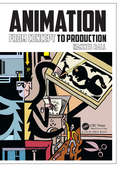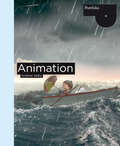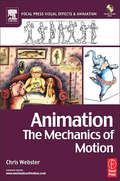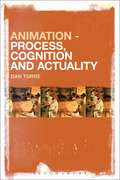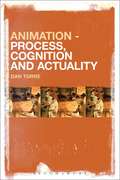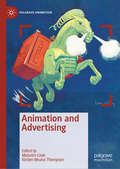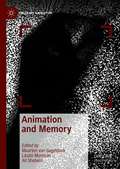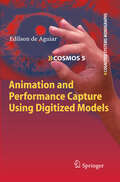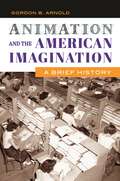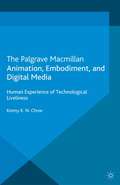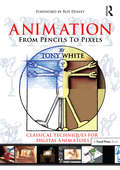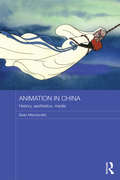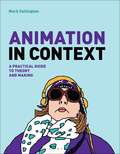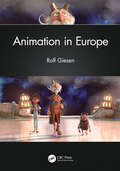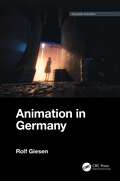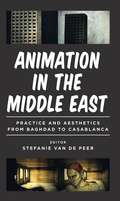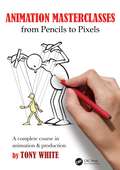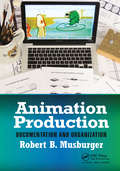- Table View
- List View
Animation: From Concepts and Production
by Hannes RallThis book explains the creation of animation from concept to production. Instead of focusing on singular aspects of animation production, talented animators can learn to make better films by understanding the process as a whole. Veteran independent filmmaker Hannes Rall teaches you how to develop an animation project from the very start of conceptual exploration though to completed production. Subjects like script, storyboarding, character and production design illuminate the pre-production process; later chapters explain the production process applied to different animation techniques like 2D animation, 3D computer animation and stop motion. This book is just the right mix of practical advice, lavish illustrations, and industry case studies to give you everything you need to start creating animation today. Key Features Learn the concepts of film animation production from an expert instructor Interviews with legends Andreas Deja, Hans Bacher and Volker Engel Robust coverage of the pre-production process, from script to storyboarding and visual development Includes a glossary and further reading recommendations
Animation (Portfolio)
by Andrew SelbyFrom scriptwriting through to production, this introduction to animation for students surveys key technical processes and examines a variety of stylistic approaches. The book includes visual examples from key animators and illustrated features on how to create exciting animation for a variety of audiences.It begins with history and context, and quickly moves on to more practical aspects of the craft. Box features outline practical information and visual examples of different animators’ work and working processes teach how to create exciting animation for any audience. A final chapter on job roles shows how students can get on in animation.This book is a vital resource for anyone who intends to make animation a part of their career.
Animation: The Mechanics of Motion (Visual Effects And Animation Ser.)
by Chris WebsterLearn the key skills you need with this practical and inspirational guide to all the fundamental principles of animation. With extended pieces on timing, acting and technical aspects, Chris Webster has created the vital learning tool to help you get the most out of your animation and develop the practical skills needed by both professionals and serious students alike. The free CD-ROM includes more than 30 animations illustrating the techniques described throughout the book as well as examples of a professional Production Schedule, Budget and Production Chart - everything you need to get started! With a Foreword by Peter Lord, Creative Director and Co-Owner of Aardman Animations and an Introduction by Mike Milne, Director of the award-winning animation house Computer Animation, Framestore CFC.
Animation – Process, Cognition and Actuality
by Dan TorreAnimation - Process, Cognition and Actuality presents a uniquely philosophical and multi-disciplinary approach to the scholarly study of animation, by using the principles of process philosophy and Deleuzian film aesthetics to discuss animation practices, from early optical devices to contemporary urban design and installations. Some of the original theories presented are a process-philosophy based theory of animation; a cognitive theory of animation; a new theoretical approach to the animated documentary; an original investigative approach to animation; and unique considerations as to the convergence of animation and actuality. Numerous animated examples (from all eras and representing a wide range of techniques and approaches – including television shows and video games) are examined, such as Fantastic Mr. Fox (2009), Madame Tutli-Putli (2007), Gertie the Dinosaur (1914), The Peanuts Movie (2015), Grand Theft Auto V (2013) and Dr. Katz: Professional Therapist (1995–2000). Divided into three sections, each to build logically upon each other, Dan Torre first considers animation in terms of process and process philosophy, which allows the reader to contemplate animation in a number of unique ways. Torre then examines animation in more conceptual terms in comparing it to the processes of human cognition. This is followed by an exploration of some of the ways in which we might interpret or 'read' particular aspects of animation, such as animated performance, stop-motion, anthropomorphism, video games, and various hybrid forms of animation.He finishes by guiding the discussion of animation back to the more tangible and concrete as it considers animation within the context of the actual world. With a genuinely distinctive approach to the study of animation, Torre offers fresh philosophical and practical insights that prompt an engagement with the definitions and dynamics of the form, and its current literature.
Animation – Process, Cognition and Actuality
by Dan TorreAnimation - Process, Cognition and Actuality presents a uniquely philosophical and multi-disciplinary approach to the scholarly study of animation, by using the principles of process philosophy and Deleuzian film aesthetics to discuss animation practices, from early optical devices to contemporary urban design and installations. Some of the original theories presented are a process-philosophy based theory of animation; a cognitive theory of animation; a new theoretical approach to the animated documentary; an original investigative approach to animation; and unique considerations as to the convergence of animation and actuality. Numerous animated examples (from all eras and representing a wide range of techniques and approaches – including television shows and video games) are examined, such as Fantastic Mr. Fox (2009), Madame Tutli-Putli (2007), Gertie the Dinosaur (1914), The Peanuts Movie (2015), Grand Theft Auto V (2013) and Dr. Katz: Professional Therapist (1995–2000). Divided into three sections, each to build logically upon each other, Dan Torre first considers animation in terms of process and process philosophy, which allows the reader to contemplate animation in a number of unique ways. Torre then examines animation in more conceptual terms in comparing it to the processes of human cognition. This is followed by an exploration of some of the ways in which we might interpret or 'read' particular aspects of animation, such as animated performance, stop-motion, anthropomorphism, video games, and various hybrid forms of animation.He finishes by guiding the discussion of animation back to the more tangible and concrete as it considers animation within the context of the actual world. With a genuinely distinctive approach to the study of animation, Torre offers fresh philosophical and practical insights that prompt an engagement with the definitions and dynamics of the form, and its current literature.
Animation and Advertising (Palgrave Animation)
by Malcolm Cook Kirsten Moana ThompsonThroughout its history, animation has been fundamentally shaped by its application to promotion and marketing, with animation playing a vital role in advertising history. In individual case study chapters this book addresses, among others, the role of promotion and advertising for anime, Disney, MTV, Lotte Reiniger, Pixar and George Pal, and highlights American, Indian, Japanese, and European examples. This collection reviews the history of famous animation studios and artists, and rediscovers overlooked ones. It situates animated advertising within the context of a diverse intermedial and multi-platform media environment, influenced by print, radio and digital practices, and expanding beyond cinema and television screens into the workplace, theme park, trade expo and urban environment. It reveals the part that animation has played in shaping our consumption of particular brands and commodities, and assesses the ways in which animated advertising has both changed and been changed by the technologies and media that supported it, including digital production and distribution in the present day. Challenging the traditional privileging of art or entertainment over commercial animation, Animation and Advertising establishes a new and rich field of research, and raises many new questions concerning particular animation and media histories, and our methods for researching them.
Animation and Memory (Palgrave Animation)
by László Munteán Maarten Van Gageldonk Ali ShobeiriThis book examines the role of memory in animation, as well as the ways in which the medium of animation can function as a technology of remembering and forgetting. By doing so, it establishes a platform for the cross-fertilization between the burgeoning fields of animation studies and memory studies. By analyzing a wide range of different animation types, from stop motion to computer animation, and from cell animated cartoons to painted animation, this book explores the ways in which animation can function as a representational medium. The five parts of the book discuss the interrelation of animation and memory through the lens of materiality, corporeality, animation techniques, the city, and animated documentaries. These discussions raise a number of questions: how do animation films bring forth personal and collective pasts? What is the role of found footage, objects, and sound in the material and affective dimensions of animation? How does animation serve political ends? The essays in this volume offer answers to these questions through a wide variety of case studies and contexts. The book will appeal to both a broad academic and a more general readership with an interest in animation studies, memory studies, cultural studies, comparative visual arts, and media studies.
Animation and Performance Capture Using Digitized Models (Cognitive Systems Monographs #5)
by Edilson de AguiarThe realistic generation of virtual doubles of real-world actors has been the focus of computer graphics research for many years. However, some problems still remain unsolved: it is still time-consuming to generate character animations using the traditional skeleton-based pipeline, passive performance capture of human actors wearing arbitrary everyday apparel is still challenging, and until now, there is only a limited amount of techniques for processing and modifying mesh animations, in contrast to the huge amount of skeleton-based techniques. In this thesis, we propose algorithmic solutions to each of these problems. First, two efficient mesh-based alternatives to simplify the overall character animation process are proposed. Although abandoning the concept of a kinematic skeleton, both techniques can be directly integrated in the traditional pipeline, generating animations with realistic body deformations. Thereafter, three passive performance capture methods are presented which employ a deformable model as underlying scene representation. The techniques are able to jointly reconstruct spatio-temporally coherent time-varying geometry, motion, and textural surface appearance of subjects wearing loose and everyday apparel. Moreover, the acquired high-quality reconstructions enable us to render realistic 3D Videos. At the end, two novel algorithms for processing mesh animations are described. The first one enables the fully-automatic conversion of a mesh animation into a skeletonbased animation and the second one automatically converts a mesh animation into an animation collage, a new artistic style for rendering animations. The methods described in the thesis can be regarded as solutions to specific problems or important building blocks for a larger application. As a whole, they form a powerful system to accurately capture, manipulate and realistically render realworld human performances, exceeding the capabilities of many related capture techniques. By this means, we are able to correctly capture the motion, the timevarying details and the texture information of a real human performing, and transform it into a fully-rigged character animation, that can be directly used by an animator, or use it to realistically display the actor from arbitrary viewpoints.
Animation and the American Imagination: A Brief History
by Gordon B. ArnoldProviding a detailed historical overview of animated film and television in the United States over more than a century, this book examines animation within the U.S. film and television industry as well as in the broader sociocultural context.From the early 1900s onwards, animated cartoons have always had a wide, enthusiastic audience. Not only did viewers delight in seeing drawn images come to life, tell fantastic stories, and depict impossible gags, but animation artists also relished working in a visual art form largely free from the constraints of the real world. This book takes a fresh look at the big picture of U.S. animation, both on and behind the screen. It reveals a range of fascinating animated cartoons and the colorful personalities, technological innovations, cultural influences and political agendas, and shifting audience expectations that shaped not only what appeared on screen but also how audiences reacted to thousands of productions. Animation and the American Imagination: A Brief History presents a concise, unified picture that brings together divergent strands of the story so readers can make sense of the flow of animation history in the United States. The book emphasizes the overall shape of animation history by identifying how key developments emerged from what came before and from the culture at large. It covers the major persons and studios of the various eras; identifies important social factors, including the Great Depression, World War II, the counterculture of the 1960s and 1970s, and the struggles for civil rights and women's rights; addresses the critical role of technological and aesthetic changes; and discusses major works of animation and the responses to them.
Animation and the American Imagination: A Brief History
by Gordon B. ArnoldProviding a detailed historical overview of animated film and television in the United States over more than a century, this book examines animation within the U.S. film and television industry as well as in the broader sociocultural context.From the early 1900s onwards, animated cartoons have always had a wide, enthusiastic audience. Not only did viewers delight in seeing drawn images come to life, tell fantastic stories, and depict impossible gags, but animation artists also relished working in a visual art form largely free from the constraints of the real world. This book takes a fresh look at the big picture of U.S. animation, both on and behind the screen. It reveals a range of fascinating animated cartoons and the colorful personalities, technological innovations, cultural influences and political agendas, and shifting audience expectations that shaped not only what appeared on screen but also how audiences reacted to thousands of productions. Animation and the American Imagination: A Brief History presents a concise, unified picture that brings together divergent strands of the story so readers can make sense of the flow of animation history in the United States. The book emphasizes the overall shape of animation history by identifying how key developments emerged from what came before and from the culture at large. It covers the major persons and studios of the various eras; identifies important social factors, including the Great Depression, World War II, the counterculture of the 1960s and 1970s, and the struggles for civil rights and women's rights; addresses the critical role of technological and aesthetic changes; and discusses major works of animation and the responses to them.
Animation, Embodiment, and Digital Media: Human Experience of Technological Liveliness
by K. ChowAnimation, Embodiment and Digital Media articulates the human experience of technology-mediated animated phenomena in terms of sensory perception, bodily action and imaginative interpretation, suggesting a new theoretical framework with analyses of exemplary user interfaces, video games and interactive artworks.
Animation from Pencils to Pixels: Classical Techniques for the Digital Animator
by Tony WhiteJust add talent!Award-winning animator Tony White brings you the ultimate book for digital animation. Here you will find the classic knowledge of many legendary techniques revealed, paired with information relevant to today's capable, state-of-the-art technologies.White leaves nothing out. What contemporary digital animators most need to know can be found between this book's covers - from conceptions to creation and through the many stages of the production pipeline to distribution. This book is intended to serve as your one-stop how-to animation guide. Whether you're new to animation or a very experienced digital animator, here you'll find fundamentals, key classical techniques, and professional advice that will strengthen your work and well-roundedness as an animator.Speaking from experience, White presents time-honored secrets of professional animaton with a warm, masterly, and knowledgeable approach that has evolved from over 30 years as an award-winning animator/director.The book's enclosed CD-Rom presents classic moments from animation's history through White's personal homage to traditional drawn animation, "Endangered Species." Using movie clips and still images from the film, White shares the 'making of' journal of the film, detailing each step, with scene-by-scene descriptions, technique by technique. Look for the repetitive stress disorder guide on the CD-Rom, called, "Mega-hurts." Watch the many movie clips for insights into the versatility that a traditional, pencil-drawn approach to animaton can offer.
Animation from Pencils to Pixels: Classical Techniques for the Digital Animator (Animation Foundation Bundle Ser.)
by Tony WhiteJust add talent!Award-winning animator Tony White brings you the ultimate book for digital animation. Here you will find the classic knowledge of many legendary techniques revealed, paired with information relevant to today's capable, state-of-the-art technologies.White leaves nothing out. What contemporary digital animators most need to know can be found between this book's covers - from conceptions to creation and through the many stages of the production pipeline to distribution. This book is intended to serve as your one-stop how-to animation guide. Whether you're new to animation or a very experienced digital animator, here you'll find fundamentals, key classical techniques, and professional advice that will strengthen your work and well-roundedness as an animator.Speaking from experience, White presents time-honored secrets of professional animaton with a warm, masterly, and knowledgeable approach that has evolved from over 30 years as an award-winning animator/director.The book's enclosed CD-Rom presents classic moments from animation's history through White's personal homage to traditional drawn animation, "Endangered Species." Using movie clips and still images from the film, White shares the 'making of' journal of the film, detailing each step, with scene-by-scene descriptions, technique by technique. Look for the repetitive stress disorder guide on the CD-Rom, called, "Mega-hurts." Watch the many movie clips for insights into the versatility that a traditional, pencil-drawn approach to animaton can offer.
Animation in China: History, Aesthetics, Media (Routledge Contemporary China Series)
by Sean MacdonaldBy the turn of the 21st century, animation production has grown to thousands of hours a year in the People’s Republic of China (PRC). Despite this, and unlike American blockbuster productions and the diverse genres of Japanese anime, much animation from the PRC remains relatively unknown. This book is an historical and theoretical study of animation in the PRC. Although the Wan Brothers produced the first feature length animated film in 1941, the industry as we know it today truly began in the 1950s at the Shanghai Animation Film Studio (SAFS), which remained the sole animation studio until the 1980s. Considering animation in China as a convergence of the institutions of education, fine arts, literature, popular culture, and film, the book takes comparative approaches that link SAFS animation to contemporary cultural production including American and Japanese animation, Pop Art, and mass media theory. Through readings of classic films such as Princess Iron Fan, Uproar in Heaven, Princess Peacock, and Nezha Conquers the Dragon King, this study represents a revisionist history of animation in the PRC as a form of "postmodernism with Chinese characteristics." As a theoretical exploration of animation in the People’s Republic of China, this book will appeal greatly to students and scholars of animation, film studies, Chinese studies, cultural studies, political and cultural theory.
Animation in China: History, Aesthetics, Media (Routledge Contemporary China Series)
by Sean MacdonaldBy the turn of the 21st century, animation production has grown to thousands of hours a year in the People’s Republic of China (PRC). Despite this, and unlike American blockbuster productions and the diverse genres of Japanese anime, much animation from the PRC remains relatively unknown. This book is an historical and theoretical study of animation in the PRC. Although the Wan Brothers produced the first feature length animated film in 1941, the industry as we know it today truly began in the 1950s at the Shanghai Animation Film Studio (SAFS), which remained the sole animation studio until the 1980s. Considering animation in China as a convergence of the institutions of education, fine arts, literature, popular culture, and film, the book takes comparative approaches that link SAFS animation to contemporary cultural production including American and Japanese animation, Pop Art, and mass media theory. Through readings of classic films such as Princess Iron Fan, Uproar in Heaven, Princess Peacock, and Nezha Conquers the Dragon King, this study represents a revisionist history of animation in the PRC as a form of "postmodernism with Chinese characteristics." As a theoretical exploration of animation in the People’s Republic of China, this book will appeal greatly to students and scholars of animation, film studies, Chinese studies, cultural studies, political and cultural theory.
Animation in Context: A Practical Guide to Theory and Making (Required Reading Range)
by Mark CollingtonAnimation in Context is an illustrated introduction to cultural theory, contextual research and critical analysis. By making academic language more accessible, it empowers animators with the confidence and enthusiasm to engage with theory as a fun, integral, and applied part of the creative process. Interviews with contemporary industry professionals and academics, student case studies and a range of practical research exercises, combine to encourage a more versatile approach to animation practice – from creating storyboards to set designs and soundtracks; as well as developing virals, 3D zoetropes and projection mapping visuals. Mark Collington focuses on a core selection of theoretical approaches that shape animation narrative, supported by a broader set of shared theoretical principles from the worlds of art, design, film and media studies. This discussion is underpinned by cross-disciplinary thinking on a range of topics including genre, humour, montage and propaganda. These are applied to the analysis of a range of animated films and projects from Disney and Animé, to independent artist-filmmakers such as Wendy Tilby, Amanda Forbis and Jerzy Kucia. These ideas are also applied to other uses of animation such as advertising, sitcom, gaming and animated documentary.
Animation in Europe
by Rolf GiesenThere is a lot one could say about animation in Europe, but above all, there is no consistent European animation. It is as disparate as the various countries involved. Audiences will certainly recognize American or Japanese animation, but in Europe, it can range from Czech, Polish, and Hungarian to Greek, Italian, Spanish, Portuguese, French, and British. Animation in Europe provides a comprehensive review of the history and current situation of animation in over 20 European countries. It features numerous interviews with artists and producers, including rare documents and firsthand accounts that illustrate the rich history of animation in Europe. Additional features include • An extensive chronology with key events in European animation • A Who’s Who of producers, directors, writers, and animators working in Europe • An examination of the origin of European animation and its influence Animation in Europe is the first book devoted entirely to this topic and, therefore, will be of value for animation buffs as well as practitioners and researchers.
Animation in Europe
by Rolf GiesenThere is a lot one could say about animation in Europe, but above all, there is no consistent European animation. It is as disparate as the various countries involved. Audiences will certainly recognize American or Japanese animation, but in Europe, it can range from Czech, Polish, and Hungarian to Greek, Italian, Spanish, Portuguese, French, and British. Animation in Europe provides a comprehensive review of the history and current situation of animation in over 20 European countries. It features numerous interviews with artists and producers, including rare documents and firsthand accounts that illustrate the rich history of animation in Europe. Additional features include • An extensive chronology with key events in European animation • A Who’s Who of producers, directors, writers, and animators working in Europe • An examination of the origin of European animation and its influence Animation in Europe is the first book devoted entirely to this topic and, therefore, will be of value for animation buffs as well as practitioners and researchers.
Animation in Germany (European Animation)
by Rolf GiesenThis book provides a comprehensive account of German animation history, as well as an analysis of the current state of the industry in competition with American and cheaper international products in the face of dwindling budgets. Covering film and TV, 2D and 3D animation, this book considers how Europe has lost its domestic territory of narratives to international competitors. A connection is made between film history and contemporary history: World War I, the Weimar Republic, National Socialism, World War II, the Federal Republic and German Democratic Republic, Reunification, the European Union, Digitalization and Globalization, and a turn of eras initiated by pandemic, war, and inflation. This book will be of great interest to academics, students, and professionals working and researching in the field of animation.
Animation in Germany (European Animation)
by Rolf GiesenThis book provides a comprehensive account of German animation history, as well as an analysis of the current state of the industry in competition with American and cheaper international products in the face of dwindling budgets. Covering film and TV, 2D and 3D animation, this book considers how Europe has lost its domestic territory of narratives to international competitors. A connection is made between film history and contemporary history: World War I, the Weimar Republic, National Socialism, World War II, the Federal Republic and German Democratic Republic, Reunification, the European Union, Digitalization and Globalization, and a turn of eras initiated by pandemic, war, and inflation. This book will be of great interest to academics, students, and professionals working and researching in the field of animation.
Animation in the Middle East: Practice and Aesthetics from Baghdad to Casablanca (20170230 Ser. #20170230)
by Stefanie Van PeerThe internationally acclaimed films Persepolis and Waltz with Bashir only hinted at the vibrant animation culture that exists within the Middle East and North Africa. In spite of censorship, oppression and war, animation studios have thrived in recent years - in Egypt, Iran, Iraq, Lebanon, Morocco, Palestine, Syria and Turkey - giving rise to a whole new generation of entrepreneurs and artists. The success of animation in the Middle East is in part a product of a changing cultural climate, which is increasingly calling for art that reflects politics. Equally, the professionalization and popularization of film festivals and the emergence of animation studios and private initiatives are the results of a growing consumer culture, in which family-friendly entertainment is big business. Animation in the Middle East uncovers the history and politics that have defined the practice and study of animation in the Middle East, and explores the innovative visions of contemporary animators in the region.
Animation in the Middle East: Practice and Aesthetics from Baghdad to Casablanca (World Cinema #20170230)
by Stefanie Van PeerThe internationally acclaimed films Persepolis and Waltz with Bashir only hinted at the vibrant animation culture that exists within the Middle East and North Africa. In spite of censorship, oppression and war, animation studios have thrived in recent years - in Egypt, Iran, Iraq, Lebanon, Morocco, Palestine, Syria and Turkey - giving rise to a whole new generation of entrepreneurs and artists. The success of animation in the Middle East is in part a product of a changing cultural climate, which is increasingly calling for art that reflects politics. Equally, the professionalization and popularization of film festivals and the emergence of animation studios and private initiatives are the results of a growing consumer culture, in which family-friendly entertainment is big business. Animation in the Middle East uncovers the history and politics that have defined the practice and study of animation in the Middle East, and explores the innovative visions of contemporary animators in the region.
Animation Masterclasses: A Complete Course in Animation & Production
by Tony WhiteToday, it is commonly believed that if you learn software, you can become an animator. Yet nothing could be further from the truth. Master animators are trained and not born. Software, as is the humble pencil, is merely yet another tool through which an animator can apply their knowledge. However, neither software nor pencils give you that knowledge, nor do they do the work for you. If you place a fully trained master animator on a computer, or give them a pencil, they’ll astound you with their mastery. However, if you put a nontrained animator on a computer, all you will have is a technician creating moving objects ・ as you’ll see all over YouTube and other video platforms. This book teaches you exactly how to become a Master Animator ・ whether you ultimately plan to use pencils, computers, drawing tablets or rigged characters. It’s a complete course in its own right, being a collection of 48 masterclasses gleaned from the author’s 50 years of experience of top-level animating, teaching and filmmaking. It will also train you in the value and application of observational gesture drawing. This book of masterclasses by a master of the art, Tony White, is entirely designed to be THE definitive reference book for students learning how to make things move really well ・ as well as how to create films once you know how to do so. A book for everyone: For home-based, self-study students: It is a perfect manual to take you from raw beginner to proven animated filmmaker. For full-time students: It is an ideal companion to supplement your full-time educational studies, which, no doubt, is overly based on software technology. For current animation professionals: It is a comprehensive archive of animation tips and techniques that will enable you to take your work to the next level. For current animation educators and instructors: It is a book that can be the ultimate curriculum and study program, enabling your own students to become the master animators of today and tomorrow.
Animation Masterclasses: A Complete Course in Animation & Production
by Tony WhiteToday, it is commonly believed that if you learn software, you can become an animator. Yet nothing could be further from the truth. Master animators are trained and not born. Software, as is the humble pencil, is merely yet another tool through which an animator can apply their knowledge. However, neither software nor pencils give you that knowledge, nor do they do the work for you. If you place a fully trained master animator on a computer, or give them a pencil, they’ll astound you with their mastery. However, if you put a nontrained animator on a computer, all you will have is a technician creating moving objects ・ as you’ll see all over YouTube and other video platforms. This book teaches you exactly how to become a Master Animator ・ whether you ultimately plan to use pencils, computers, drawing tablets or rigged characters. It’s a complete course in its own right, being a collection of 48 masterclasses gleaned from the author’s 50 years of experience of top-level animating, teaching and filmmaking. It will also train you in the value and application of observational gesture drawing. This book of masterclasses by a master of the art, Tony White, is entirely designed to be THE definitive reference book for students learning how to make things move really well ・ as well as how to create films once you know how to do so. A book for everyone: For home-based, self-study students: It is a perfect manual to take you from raw beginner to proven animated filmmaker. For full-time students: It is an ideal companion to supplement your full-time educational studies, which, no doubt, is overly based on software technology. For current animation professionals: It is a comprehensive archive of animation tips and techniques that will enable you to take your work to the next level. For current animation educators and instructors: It is a book that can be the ultimate curriculum and study program, enabling your own students to become the master animators of today and tomorrow.
Animation Production: Documentation and Organization
by Robert B. Musburger, PhDThis text follows the animation production by concentrating on the documentation necessary to accurately and professionally organize each step of the process. Examples of each piece of paperwork needed to complete the project will be shown. Many newcomers to the field are not experienced in the basic processes to organize their project in an orderly manner. The result is a chaotic, inefficient, and incomplete product. Readers are presented with a step-by-step guide to organizing the process by following professional standards in creating needed and useful documentation for all animators, whether creating in cells, stop-motion, experimental, or computer graphic productions. Key Features Provides simplified but intense coverage of animation production. Written to be easily read by newcomers to the field, ranging from students to professionals. Each chapter contains objectives, summaries, examples of forms, key terms, and examples of how professionals use the same techniques. This book provides both students and instructors an easily understandable explanation of the system and the directions on how to prepare documentation.
